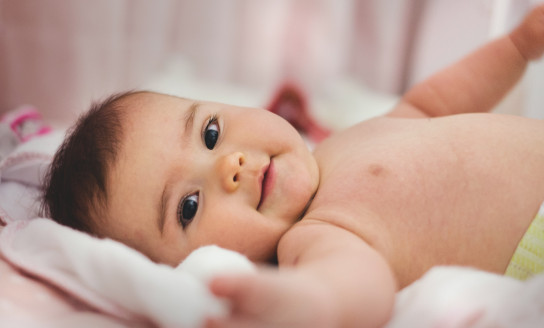Caring for your baby’s skin
The first few weeks
A new baby’s skin is not fully mature at birth so it’s important to treat your baby’s skin gently. Their skin will gradually adjust to their new environment in the first six to 12 weeks and form an invisible protective barrier (called the acid mantle). You may notice your baby's skin is sensitive and dry. This is normal and most babies’ skin will have settled by three months.
Tips for baby skin care
Bathing
- You don’t need to bath your baby every day. Every second day or a few times a week is fine.
- Pat, rather than rub, your baby’s skin to dry them off after a bath.
Powders and soaps
- Do not use antimicrobial cleansers or any that contain chlorhexidine, as these are harsh on your baby’s skin.
- Be cautious of herbal cleansers, as they can cause a skin reaction.
- Do not use talcum powder.
Moisturisers
- Most skin dryness will clear up on its own, but if you use a moisturiser, choose a simple one that has no added perfumes or ingredients.
- Try to use a moisturiser that has been tested for use on babies.
Other tips
- Keep your baby warm, but not hot. Being hot can dry their skin.
- If you have a family history of skin issues (like eczema) your baby’s skin care may need extra care so talk to your midwife, nurse or doctor.
Birthmarks
Many babies are born with one or more birthmarks. There are many types of birthmarks, and some are common, while others are less-common. Talk to your nurse, midwife or doctor if you notice any spots that you’re not sure about.
Common birthmarks
Dark red or pink patches (called stork bites) commonly appear on the eyelids, between the eyebrows, and on back of the neck and are nothing to worry about. Marks often will become more visible in the first few weeks (especially when your baby is hot or crying) and they'll fade by the end of the first year.
Slate-grey naevus (previously known as Mongolian spots) are dark blue patches that are present on the skin at birth. They typically appear on the lower back or the bottom, and sometimes occur on other parts of the body like the shoulders or ankles. They are not bruises (they do not have any yellow that is normally seen with a bruise) and will likely fade in the first few months or years. Darker Slate-grey naevus spots may be visible for longer and are common in children with darker skin.
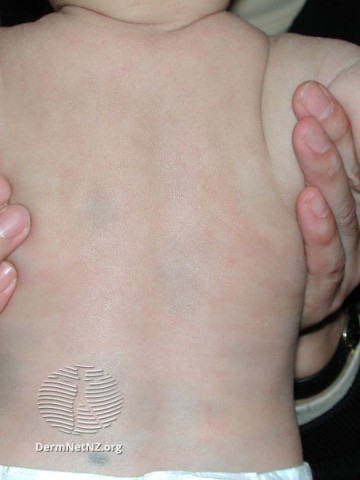
(DermNet NZ)
A red birthmark (also called haemangioma) is often small at birth and then grows and forms reddish lumps over the first year before it fades and disappears in the second year. They are common and don’t require treatment unless they are near your child's eye or mouth, or interfere with your child’s normal functions. If you notice your baby has a red spot mark let your nurse or doctor know.
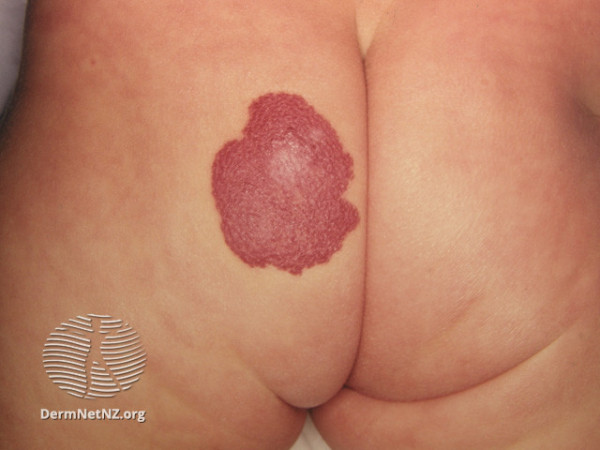
(DermNet NZ)
A flat purple birthmark (also called a port wine stain) is present at birth and will grow with your child. The mark is permanent, but can be treated by a skin specialist when your child is older.
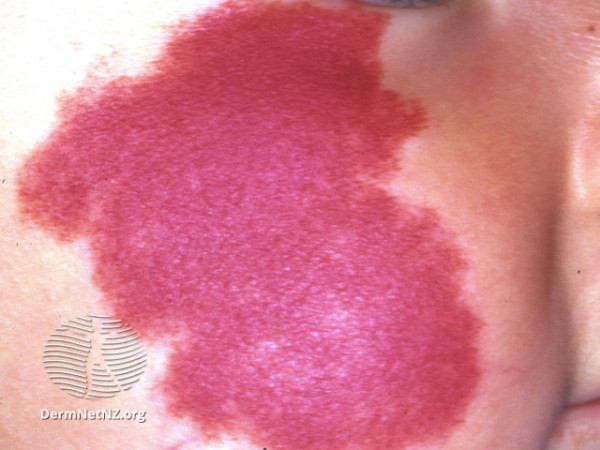
(DermNet NZ)
Common skin conditions in babies
Baby acne (Hormonal spots)
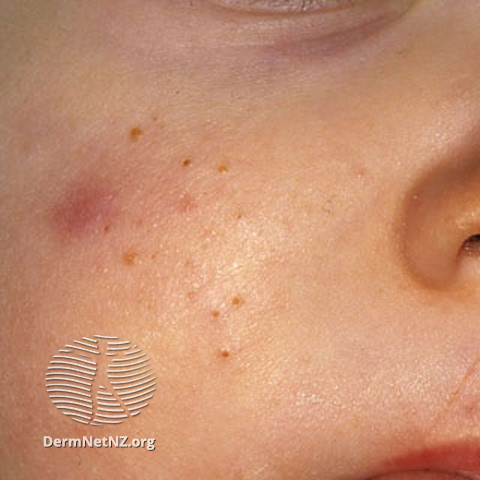
(DermNet NZ)
Some babies will develop spots around three to six weeks old that look like acne on their face, head and above the nipple line. These spots are caused by changing hormones after birth and are completely normal.
The spots can look worse when your baby is hot or after they’ve been crying. No treatment or creams are needed, because they usually heal naturally after a few weeks.
Toxic erythema
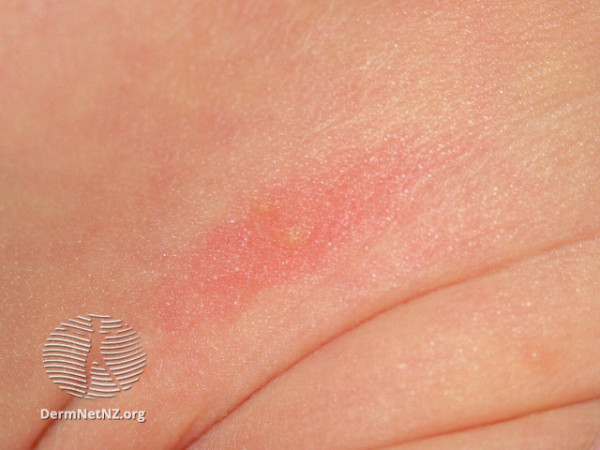
(DermNet NZ)
This is a common rash that many babies get in their first one to two weeks. It looks like an insect bite and is red with a yellow center. The rash comes and goes all over the body, but otherwise your baby will be fine, apart from the rash. No special treatment is needed for toxic erythema because it goes away by itself. However, if your baby has a rash and is unwell with other symptoms you should immediately call PlunketLine or your doctor.
Heat rash
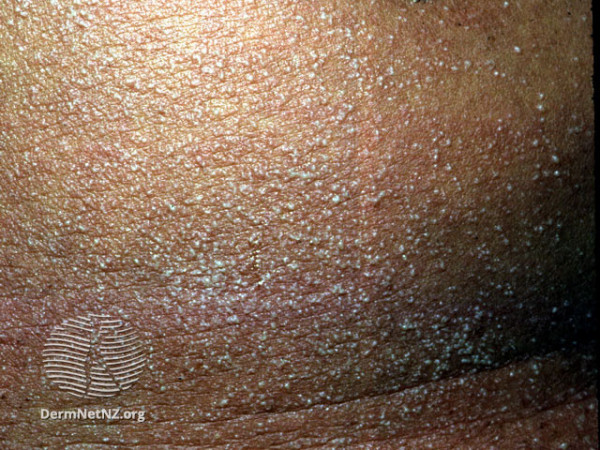
(DermNet NZ)
Babies’ sweat glands are not fully developed, which means that the glands can get blocked if your baby gets too hot. Sweat is trapped under the skin and blisters can pop up –this is called a heat rash.
Usually a heat rash will appear as small pink, red or clear blisters on your child’s face, neck and skin folds – especially in the nappy area. The rash will often fade or disappear once your baby is cool.
Take your little one to see a doctor if:
- your baby is generally unwell, has a fever or isn’t feeding well
- the blisters have yellow or green pus – this could mean that they are infected
- the rash lasts longer than three days.
To help prevent heat rash
- Make sure your baby stays cool or warm.
- Use clothes and bedding made from natural materials, like cotton, bamboo and wool as these help the skin get rid of moisture and heat and stop your baby getting sweaty and hot.
Milk spots
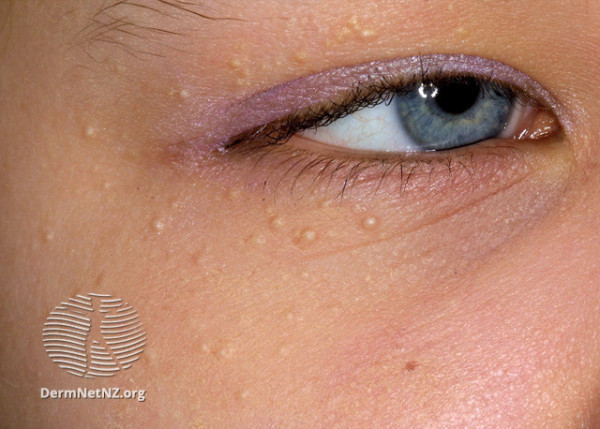
(DermNet NZ)
Milk spots (also called milia) are tiny pearly-white bumps that occur just under the surface of your baby’s skin. Almost half of infants will have milk spots on the face, with most cases clearing up after the first four weeks. Treatment is usually not needed, but if you are concerned about your little one, call PlunketLine, or talk to your nurse or doctor.
Jaundice
What is jaundice?
Jaundice is when your baby’s skin and whites of the eyes are tinged yellow. Mild jaundice is very common in young babies and happens as they get rid of extra red blood cells from their birth. In rare cases, jaundice may be a sign of a serious liver disease.
How long does jaundice last?
Jaundice usually starts a few days after a baby is born and will settle down within seven to 10 days.
When to visit a doctor
See your doctor immediately if your baby:
- has yellow skin or eyes
- has dark wee (yellow or brown) or pale poos
- is sleepy and difficult to wake for feeds
- isn’t feeding well
- is jaundiced in the first 24 hours of life
- stays jaundiced after the first two weeks of life.
Jaundice in babies
